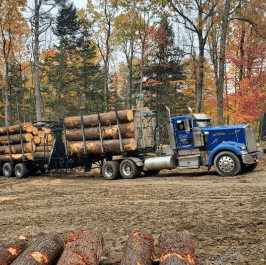Forests represent a staggering range of diversity in terms of time and landscape. Disturbance tends to be a critical component of diversity; harvesting timber offers a measure of control of how and when these disturbances occur.
 Why Harvest Timber?
Why Harvest Timber?
Forestry services are offered at the hands of trained professionals who manage forests for sustainability. While it’s true that excessive harvesting of timber can cause catastrophic consequences, not controlling the growth can also be highly damaging. Here are three reasons for harvesting timber:
Attaining Maximum Product Value
As trees mature, their growth rates decrease. But since it has already reached its maturity, the most sizeable amount of income can be generated by selling this wood type. However, forestry services are mindful of preservation of habitats within old forest trees. For this reason, part of the forest is left during logging.
Improving Health and Value of the Forest
Removal of an older, diseased plant also contributes to the growth of heathier trees, increasing their value. With careful planning, it’s possible to increase the productivity levels of individual plants and improve the living conditions of wild animals. For this reason, it’s crucial to take effective measures to encourage the regeneration of trees, which accelerates a different species’ growth. For example, using the clearcutting method for harvesting timber is suitable for stimulating white pine, spruce fir, and yellow birch.
Creating a Fire Resistant Forest
Despite all forests being vulnerable to fire to some degree, harvesting timber can reduce the occurrence of these disasters as it increases the distance between crowns making it difficult for fire to spread between trees located farther apart. This is less of a concern in Maine and New Hampshire than on the West coast, but during severe droughts, you can enjoy more peace of mind if your woodland is prepared to resist fire danger.
Methods for Harvesting Timber
There are three types of methods used by timber harvesting services applied to specific types of forests. While they’re fairly different, they have a few things in common: Firstly, they provide the wood fiber used in thousands of products we use daily. Secondly, they further enhance the social, ecological, and economic value of the forest. Thirdly, they promote environmental conditions that can further aid in the regeneration of the forest.
Clearcutting
This method is the best solution for forests where sprouts and seedlings require fuller exposure to sunlight. In terms of growth, buds and seeds respond fairly well to the ground that has been warmed with an abundance of sunlight. This is the most ecological method for harvesting as it limits the spread of natural fires and diseases while simultaneously accommodating the requirements of the type of forest.
That said, not all plants require abundant light to grow; some plants require partial shading or are ‘tolerants’ that develop well in both conditions. This is one more reason you need an expert to guide you, to make sure you’re using the right harvest method for your woodland and goals.
Shelterwood
This system is sandwiched between the extremes of clearcutting and selective systems for harvesting timber. The forest is removed in multiple stages, but with each stage successively laying ground for optimum environmental conditions for the regeneration of harvested trees.
Selective Cutting
Selective cutting systems tend to be the most complex method for harvesting. It’s brought into play when the stands of trees become overly dense, increasing forest-related health risks. Successful removal of higher-risk trees improves the character and quality of the forest significantly. The sunlight seeping in through the partially opened canopy promotes tree health and encourages seedlings to grow. If not harvested, older trees tend to die and are eventually replaced by younger trees.
However, it’s important to refrain from unscrupulous practices that can damage the forest, such as high grading or diameter limit cutting. You must also be sure of the type of forest you’re harvesting, as certain trees can’t regenerate under shady conditions and may also inflict damage.
The Best of Timber Harvest Services
William A. Day Logging is a family-owned business that has been operational for over 30 years in Maine and New Hampshire, United States. The forest management planning company is run by Brent Day, Scott Day, and Brian Day, who offer wood or timber harvesting services, lot clearing, and trucking services. We also offer other Logging services, including wood lot assessment and log trucking.
William A. Day Logging also retails three distinct types of firewood, including (1) seasoned firewood that’s left on Mother Nature to dry out, (2) kiln dried firewood that’s dried out in a kiln to reduce drying time and to kill living organisms in the wood, and (3) green firewood that hasn’t been dried out at all.
Contact William A. Day Logging for more information on timber harvesting services in Maine and New Hampshire.
